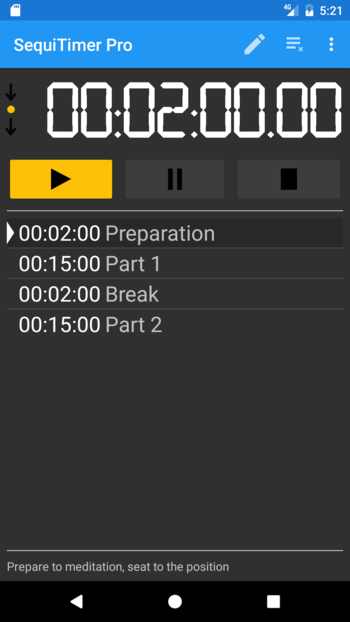The workout example
An effective workout involves repeating of power and rest phases. SequiTimer allows you to create sequences with repeating timers to lead you during your workout without need to watch the device, so you can fully concentrate on the workout.
In this example we use a training set for running. The first timer is for the warmup phase. Then we have five repeating of the power and slow phase and at the end one additional cold down phase. The timers use the speech output to inform you about the tempo change. To use the speech output you have to install Google's app Google Text-to-speech

The cooking example
In this example you’ll learn how to use SequiTimer as a cooking timer. It is obvious that recipes often contain more actions which have time boundary. But these actions seldom follow right one after another. SequiTimer allows to set the pause after the timer end. When such timer ends it doesn’t start the next timer, but waits for manual trigger of the next one. It allows you to put all timers used in a recipe into one sequence.
In this example, we will use a simple recipe for a quiche crust. We will use two timers, one for the dough resting and second for baking.
- The Recipe:
- 160g all-purpose flour
- 80g butter
- Water
- Pinch of salt
Mix fairly flour with butter and pinch of salt, then add slowly water and blend until dough becomes firm and soft. Then make a loaf and cover it with kitchen foil. Put it into fridge and start the first timer. After the timer ends spread the dough on a floured desk to size of a form. Put it into the form and adjust the dough to fit the form. Then stab it with a fork and put baking paper on it. Spread dry beans on the paper, to avoid the dough to grow up. Then put it into an oven at 180°C/365°F and start the second timer.
Make your own sequences for your favorite recipes following this example.

The meditation example
One of the reasons why the SequiTimer was made, was to have a highly adjustable meditation timer. Beginners often tend to suffer of a leg pain and numbness. Therefore it is a good decision to insert a short break for the posture change in the middle of the meditation. The meditation is controlled by the sound of a bell, the number of strikes denotes the beginning, the break and the end of the meditation.
This example contains a sequence of timers for a meditation with one break inserted. In this example we demonstrate how to use sounds in the beginning and at the end of a timer.
The first timer is the preparation phase for the meditation posture setup. The second timer starts the meditation with three bell rings and ends it after 15 minutes with two bell rings. The third timer is for the short break and finally the last timer for the second part of the meditation. It starts with three bell rings and ends with one.
Try this sequence, adjust the timers according to your needs and save it for everyday use. You can also make different versions for weekend, morning or evening meditation.
